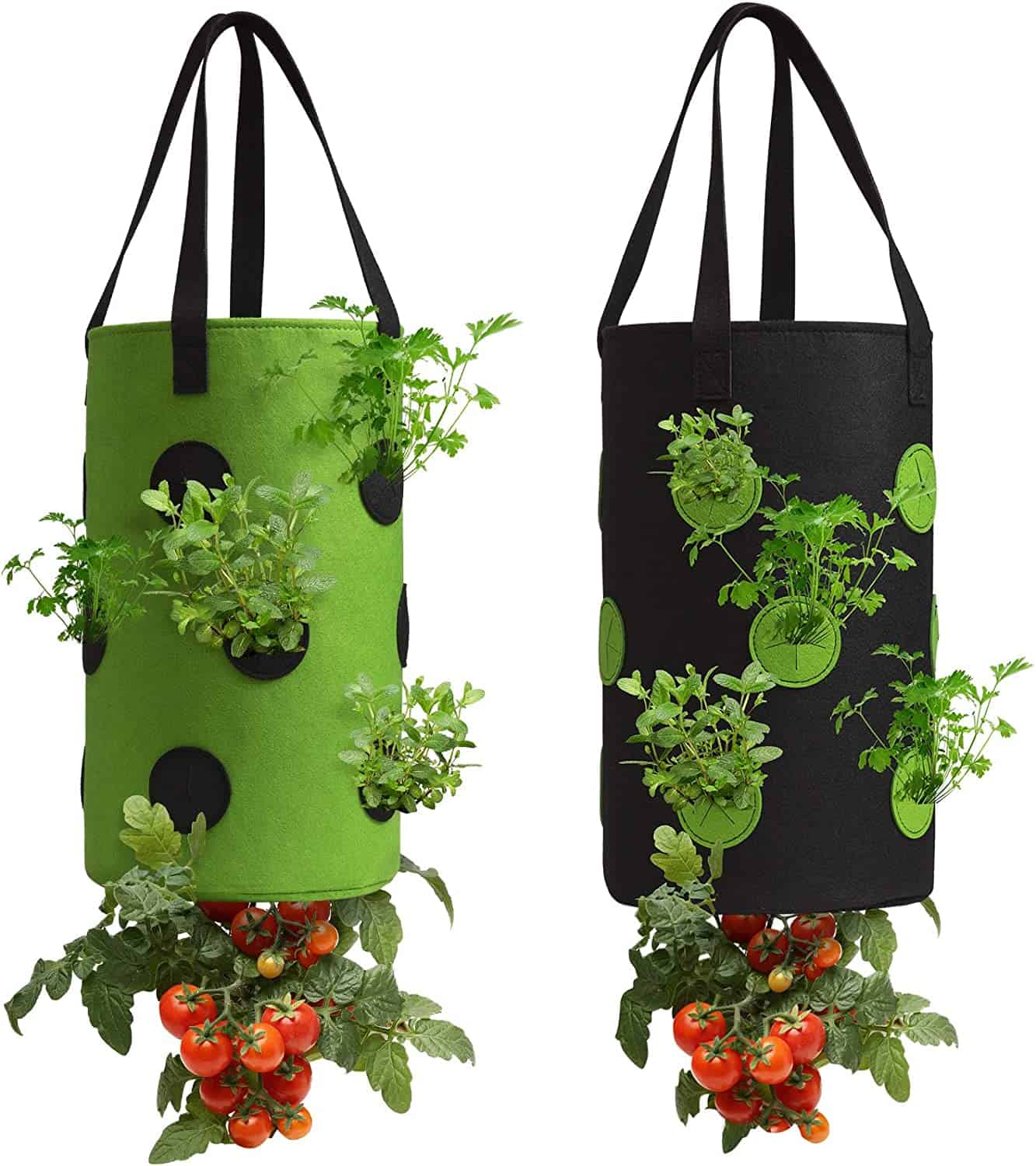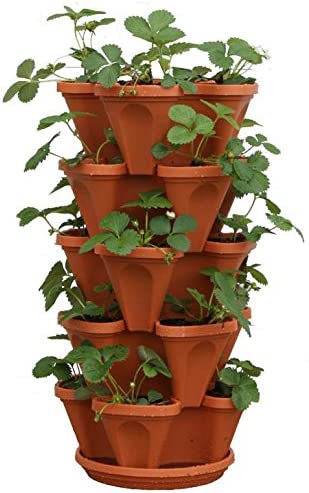If you’re looking to grow strawberries but don’t have the space for a garden, growing them in pots is a great option. Not only does it save space, but it also allows you to have fresh strawberries right at your fingertips. However, growing strawberries in pots requires a specific type of soil to ensure proper growth and yield.
This post may contain affiliate links.
When it comes to the best soil for strawberries in pots, you want to look for a loose, loamy potting mix that will hold moisture but quickly drain away any excess water. It’s important to use a container with a drainage hole in the bottom to prevent water from accumulating and causing root rot. Additionally, you want to make sure the soil has proper pH levels and is rich in nutrients to support healthy growth.

Related Article: Growing Grapes in Pots: Tips and Tricks for Successful Container Gardening
Fortunately, there are several options available for soil mixes that are ideal for growing strawberries in pots. In this article, we’ll explore the top picks recommended by experts and provide tips on how to prepare the soil for planting. Whether you’re a seasoned gardener or new to growing strawberries, our guide will help you achieve a bountiful harvest of delicious, juicy berries.
Understanding Strawberry Varieties
When it comes to growing strawberries in pots, it’s important to choose the right variety for your needs. There are three main types of strawberry varieties: June-bearing, day-neutral, and everbearing. Each type has its own unique characteristics and growing requirements.
Related Article: Growing Hydrangeas in Pots
June-Bearing Strawberries
June-bearing strawberries are the most common type of strawberry and are known for producing a large crop of berries in late spring to early summer. These varieties typically produce one large harvest per year, making them ideal for preserving or making jams and jellies. Some popular June-bearing varieties include Allstar, Chandler, and Jewel.
Day-Neutral Strawberries
Day-neutral strawberries are a newer type of strawberry that can produce fruit throughout the growing season. These varieties don’t require a specific day length to produce fruit, making them ideal for growing in pots indoors or in areas with shorter growing seasons. Some popular day-neutral varieties include Seascape, Tribute, and Tristar.
Everbearing Strawberries
Everbearing strawberries are similar to day-neutral varieties in that they can produce fruit throughout the growing season. However, they typically produce two to three smaller harvests per year rather than a single large harvest. Some popular everbearing varieties include Alpine, Ozark Beauty, and Quinault.
When choosing a strawberry variety for your pot, consider your growing conditions and goals. If you want a large crop of berries for preserving, a June-bearing variety may be the best choice. If you want a longer harvest season, a day-neutral or everbearing variety may be a better fit.
It’s also important to consider the specific variety within each type. Some June-bearing varieties may produce earlier or later than others, while some day-neutral varieties may be better suited for indoor growing. Do your research and choose a variety that fits your needs and growing conditions.
Related Article: Grow Big Tomatoes in Pots
Choosing the Right Container
When it comes to growing strawberries in pots, choosing the right container is crucial. The container you choose will have a direct impact on the health and growth of your strawberry plants. Here are some things to consider when choosing the right container for your strawberries.
Pot Types
There are several types of pots to choose from, including plastic pots, hanging baskets, hanging grow bags, and even strawberry pots. Each type of pot has its own advantages and disadvantages, so it’s important to choose the one that best suits your needs.
2 Pack Black and Green Upside Down Tomato & Herb Planter, Hanging Durable Aeration Fabric Strawberry Planter Bags 5-Tier Strawberry Planter Pot, 5 Pots
5-Tier Strawberry Planter Pot, 5 Pots
Plastic pots are lightweight and easy to move around, making them a good choice if you plan to move your strawberries to different locations throughout the day. Hanging baskets are a great option if you have limited space, as they can be hung from a wall or ceiling. Grow bags are a good choice if you want to grow multiple plants in a single container, as they provide plenty of space for roots to grow. Strawberry pots are specifically designed for growing strawberries and have multiple planting pockets, making them a good choice if you want to grow a lot of strawberries in a small space.
Importance of Drainage
No matter what type of container you choose, it’s important to ensure that it has proper drainage. Without proper drainage, excess water can build up in the bottom of the container, leading to root rot and other problems.
Make sure your container has drainage holes in the bottom to allow excess water to escape. If your container doesn’t have drainage holes, you can drill them yourself using a drill and a bit that’s the appropriate size for your container. It’s also a good idea to place a layer of stones or gravel in the bottom of your container to help improve drainage.
Related Article: How to Hang Plants from the Ceiling
In addition to proper drainage, it’s important to choose a container that’s large enough for your strawberry plants to grow and thrive. A container that’s too small can lead to stunted growth and poor yields. As a general rule, choose a container that’s at least 12 inches deep and wide.
By choosing the right container for your strawberries and ensuring proper drainage, you can help ensure that your plants grow healthy and strong.
Best Soil for Strawberries
If you’re planning to grow strawberries in pots, choosing the right soil is crucial to ensure a healthy and productive harvest. Understanding soil composition and pH levels are two essential factors to consider when selecting the best soil for strawberries.
Understanding Soil Composition
The ideal soil for strawberries in pots should be a well-draining potting mix that is rich in organic matter. A good potting mix should contain a blend of peat, perlite, compost, and coco coir. These ingredients help to create a light, fluffy soil that retains moisture while allowing excess water to drain away.
When selecting a potting mix, look for one that is specifically designed for growing fruits and vegetables. Avoid using garden soil or soil from your yard, which can be too dense and compact for container gardening.
Related Article: What to Do with a Flat of Strawberries
Importance of pH Level
The pH level of your soil is another critical factor to consider when growing strawberries in pots. The ideal pH for strawberries is between 5.5 and 6.5. If the pH level is too high or too low, it can affect the plant’s ability to absorb nutrients from the soil.
To ensure the proper pH level, you can either test the soil yourself using an inexpensive pH meter or purchase a pre-mixed potting soil with the correct pH level. Most potting soils are designed to have a neutral pH level, but it’s always a good idea to double-check before planting.
Related Article: Growing Blackberries in Pots: Tips and Tricks
Planting and Care
Growing strawberries in pots is a great way to enjoy the delicious fruit even if you don’t have a lot of space. However, it’s important to take proper care of your potted strawberry plants to ensure that they grow strong and produce a bountiful harvest. Here are some tips to help you care for your potted strawberries:
Planting Process
When planting your strawberries in pots, make sure to choose a pot that is at least 12 inches deep and wide enough to accommodate the size of the plant. Fill the pot with a high-quality potting mix that is rich in nutrients and retains moisture. You can also add slow-release fertilizer to the soil to provide your plants with the necessary nutrients.
Plant your strawberries in the pot so that the crown is level with the soil surface. Water your plants thoroughly after planting to help settle the soil and promote root growth.
Related Article: Freezing Strawberries
Watering and Fertilizing
Water your potted strawberry plants regularly, especially during hot summer months. Make sure that the soil is moist but not waterlogged. You can also use a liquid fertilizer to provide your plants with the necessary nutrients. However, be careful not to over-fertilize your plants, as this can lead to poor fruit quality and slow growth.
Pruning and Harvesting
To care for your strawberries, it’s important to prune your plants regularly. Remove any dead or damaged leaves and runners to promote healthy growth. You can also pinch off the first flowers that appear to encourage your plants to focus on root and leaf growth.
When your strawberries are ripe, pick them promptly to encourage the plant to produce more fruit. You can also remove any diseased or damaged fruit to prevent the spread of disease.
Troubleshooting Common Issues
Growing strawberries in pots can be a rewarding experience, but it’s not without its challenges. Here are some common issues you may encounter and how to address them.
Dealing with Pests and Diseases
Pests and diseases can wreak havoc on your strawberry plants, so it’s important to stay vigilant. Here are some tips for dealing with common issues:
- Aphids: These tiny bugs can suck the life out of your plants. If you notice them, try spraying your plants with a mixture of water and dish soap.
- Spider mites: These pests can cause discoloration and stunted growth. Try spraying your plants with a mixture of water and neem oil.
- Fungal diseases: If you notice mold or other signs of fungal disease, try removing infected leaves and spraying your plants with a fungicide.
Related Article: 7 Best Recipes for Canning Strawberries
Addressing Light and Temperature Issues
Strawberry plants need plenty of sunlight and the right temperature to thrive. Here are some tips for addressing light and temperature issues:
- Not enough light: If your plants aren’t getting enough light, try moving them to a sunnier location. If that’s not possible, consider using grow lights.
- Too much heat: Strawberry plants prefer cooler temperatures, so if you live in a hot climate, try placing your pots in a shaded area or using a shade cloth to protect them from the sun.
- Not enough water: Strawberry plants need consistent moisture, so make sure your pots have proper drainage and water them regularly. If you notice the soil is drying out quickly, you may need to water more frequently.
- Too much water: On the other hand, overwatering can lead to root rot and other issues. Make sure your pots have proper drainage and don’t water them too frequently.
- Pests and animals: Birds, squirrels, and other animals may be attracted to your strawberry plants. Consider using netting or other protective measures to keep them away.
- Dormant period: Strawberry plants go dormant during the winter months. If your plants aren’t producing fruit during this time, don’t worry – they’ll start up again in the spring.
- Low yield: If you’re not getting as much fruit as you’d like, make sure your plants have enough space to grow and prune off any runners to encourage more fruit production.
- Fertilizer: Strawberry plants benefit from regular fertilization. Try using a balanced fertilizer or adding bat guano to your soil for an extra boost.
- Drought: If you live in a dry climate, make sure to water your plants regularly and consider using mulch to help retain moisture.
- Soil quality: Finally, make sure you’re using the right soil for your strawberry plants. They need well-draining soil with a slightly acidic pH. If you’re having issues, consider testing your soil and making adjustments as needed.
Growing strawberries in pots is a fun and rewarding way to enjoy fresh berries all season long. With the right soil, pot size, and care, you can grow healthy and delicious strawberries right on your balcony or patio.
Frequently Asked Questions
What is the ideal soil mix ratio for growing strawberries in pots?
The ideal soil mix ratio for growing strawberries in pots is 1:1:1. This means equal parts of peat moss, perlite, and compost. This combination will provide the necessary nutrients, drainage, and aeration for your strawberry plants to thrive.
How should I prepare my strawberry plants in pots for the end of the season?
At the end of the season, you should remove any dead or dying leaves and stems from your strawberry plants. You should also cut back the foliage to about 1 inch above the soil level. This will help your plants conserve energy during the winter months and come back strong in the spring.
Is adding sand to my soil mix beneficial for growing strawberries in pots?
Adding sand to your soil mix can improve drainage, but it can also cause your soil to become too dry. Instead, you should use perlite or vermiculite to improve drainage and aeration in your soil mix.
Can I use potting soil to grow strawberries in pots?
Yes, you can use potting soil to grow strawberries in pots. However, you should choose a high-quality potting soil that is specifically formulated for container gardening. Look for a potting soil that contains peat moss, perlite, and vermiculite for optimal drainage and aeration.
Follow my gardening board on Pinterest.





